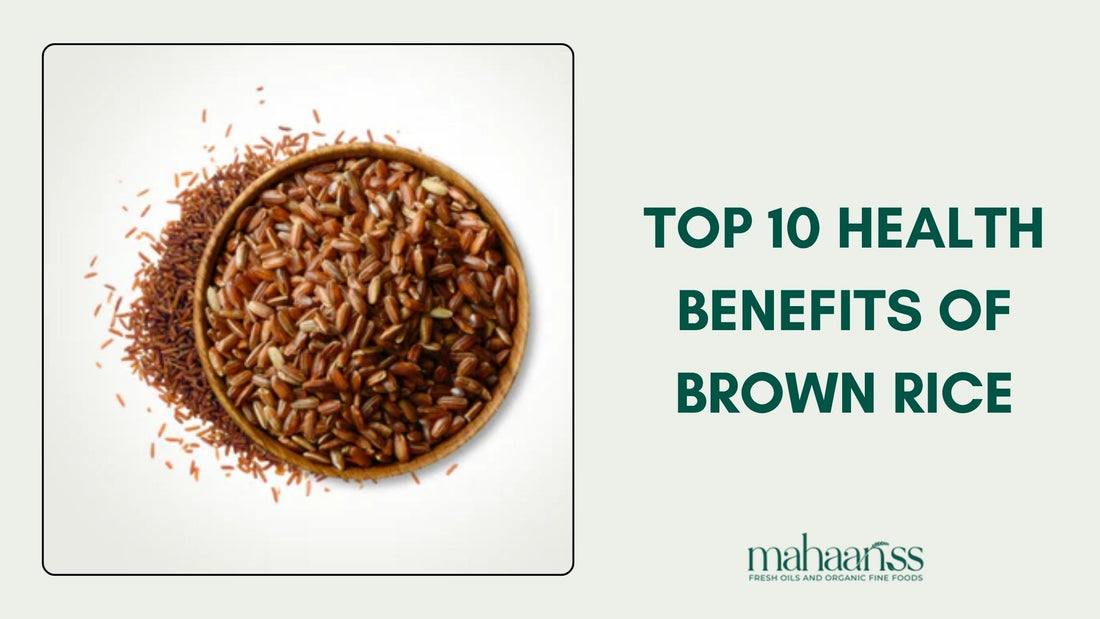
Top 10 Health Benefits of Brown Rice
Brown rice is one of the healthiest grains you can include in your daily diet. Unlike white rice, which is processed and stripped of its outer layers, brown rice retains its bran and germ. This makes it rich in essential nutrients, fiber, and antioxidants. People around the world are turning to brown rice as a healthier alternative that supports weight management, heart health, and overall wellness.
In this blog, we’ll explore the top 10 health benefits of brown rice and why it deserves a regular spot in your meals.
1. Supports Healthy Digestion
One of the most important health benefits of brown rice is its ability to support good digestion. Brown rice is rich in dietary fiber, especially insoluble fiber, which adds bulk to your stool and promotes regular bowel movements. This helps prevent constipation and improves gut health.
The natural fiber in brown rice also nourishes beneficial gut bacteria, which play a major role in nutrient absorption and immune function. By improving digestion, brown rice helps your body get the most out of the nutrients in your food.
2. Promotes Heart Health
Another key health benefit of brown rice is that it supports a healthy heart. The fiber, lignans, and plant compounds present in brown rice help reduce cholesterol levels, particularly LDL (bad cholesterol). Studies have shown that diets high in whole grains, like brown rice, lower the risk of heart disease.
Magnesium in brown rice also plays an important role in maintaining normal blood pressure. Replacing white rice with brown rice can be a simple yet effective way to protect your heart in the long run.
3. Helps Manage Weight
If you are trying to lose weight or maintain a healthy body composition, brown rice can be a great choice. It keeps you full for a longer time because of its high fiber content, which helps reduce overeating.
The complex carbohydrates in brown rice provide sustained energy, preventing sudden spikes and drops in blood sugar that often trigger cravings. Including brown rice in your meals can help you manage calorie intake without feeling deprived, making it one of the most practical health benefits of brown rice for weight control.
4. Stabilizes Blood Sugar Levels
For people with diabetes or those at risk of developing it, brown rice is a better option than white rice. Its lower glycemic index means it doesn’t cause rapid spikes in blood sugar.
The presence of magnesium and fiber further helps regulate insulin levels and glucose metabolism. Several studies have found that individuals who consume whole grains regularly have a lower risk of type 2 diabetes.
This makes stable blood sugar management one of the most significant health benefits of brown rice.
5. Boosts Energy Naturally
Brown rice is packed with complex carbohydrates that serve as a steady source of energy. Unlike refined grains that give you a quick burst of energy followed by fatigue, brown rice provides sustained fuel for your body throughout the day.
It also contains essential nutrients like manganese, which helps your body convert carbohydrates and proteins into energy. This makes brown rice an ideal pre-workout meal or a great addition to lunch for those with physically demanding routines.
6. Supports Healthy Cholesterol Levels
A well-known health benefit of brown rice is its ability to maintain healthy cholesterol levels. The oil present in brown rice, known as rice bran oil, has been shown to lower bad cholesterol while increasing good cholesterol (HDL).
Additionally, the fiber content helps eliminate excess cholesterol from the body by binding it in the digestive tract. Over time, this contributes to better heart health and reduced risk of cardiovascular disease.
7. Rich in Antioxidants
Brown rice is a natural source of antioxidants, including phenolic compounds, flavonoids, and selenium. These antioxidants help combat oxidative stress in the body by neutralizing free radicals that cause cell damage.
Regular consumption of antioxidant-rich foods like brown rice supports healthy aging and reduces the risk of chronic diseases such as cancer, diabetes, and heart disease. This makes the antioxidant protection one of the vital health benefits of brown rice for long-term wellness.
8. Strengthens Bones
Brown rice contains magnesium, phosphorus, and calcium—minerals that are essential for strong and healthy bones. Magnesium, in particular, works alongside calcium to maintain proper bone density and prevent conditions like osteoporosis.
Including brown rice in your daily meals can help ensure that your bones remain strong as you age. This is one of the underrated yet valuable health benefits of brown rice that contributes to overall physical strength.
9. Improves Metabolism
The B vitamins found in brown rice—such as B1 (thiamine), B3 (niacin), and B6 (pyridoxine)—play a crucial role in supporting your body’s metabolism. These vitamins help convert food into energy efficiently and assist in various enzyme reactions that support the nervous system and brain function.
Because of this, eating brown rice regularly can help keep your metabolism active and balanced. Improved metabolism leads to better energy levels and helps your body function at its best.
10. Supports Overall Detoxification
Last but not least, one of the health benefits of brown rice is its natural detoxifying effect. Brown rice contains selenium, an essential mineral that supports liver function and helps the body remove toxins more efficiently.
The fiber content also aids detoxification by cleansing the digestive tract and promoting regular elimination. By supporting both the liver and digestive system, brown rice helps your body stay clean and healthy from the inside out.
How to Include Brown Rice in Your Diet
Including brown rice in your diet is simple and versatile. You can replace white rice in almost any recipe, from stir-fries and curries to salads and soups. Here are a few easy ways to enjoy it:
1. Use cooked brown rice as a base for Buddha bowls.
2. Add it to vegetable stir-fries for extra fiber.
3. Mix it with lentils or beans for a protein-rich meal.
4. Make brown rice porridge for a healthy breakfast.
5. Use it in place of white rice in your favorite biryani or fried rice recipe.
When cooking brown rice, remember that it takes slightly longer than white rice. Soak it for 30 minutes before cooking to reduce the time and improve texture.
Final Thoughts
Switching from white rice to brown rice may seem like a small change, but it can have a big impact on your health. From better digestion and heart protection to weight management and detoxification, the health benefits of brown rice are numerous and scientifically supported.
By making brown rice a regular part of your diet, you’re choosing a wholesome grain that fuels your body, protects your heart, and keeps your digestive system strong. Whether you are focused on fitness, managing a health condition, or simply improving your daily nutrition, brown rice is a simple and natural choice for a healthier lifestyle.
Frequently Asked Questions (FAQs)
1. Is brown rice healthier than white rice?
Yes, brown rice is healthier than white rice because it retains its bran and germ layers, which are rich in fiber, vitamins, and minerals. This makes it more nutritious and beneficial for digestion, heart health, and overall wellness.
2. Can brown rice help with weight loss?
Yes, brown rice can support weight loss. Its high fiber content keeps you full longer, helping to control hunger and reduce calorie intake. It also provides steady energy without sudden blood sugar spikes, making it an excellent choice for healthy weight management.
3. How often should I eat brown rice for maximum benefits?
You can eat brown rice several times a week as part of a balanced diet. Including it in lunch or dinner a few days a week can help you enjoy the key health benefits of brown rice, such as better digestion, improved cholesterol, and stable energy levels.
4. Is brown rice good for people with diabetes?
Absolutely. Brown rice has a lower glycemic index than white rice, meaning it raises blood sugar more slowly. It also contains magnesium and fiber, which improve insulin sensitivity and glucose control — making it a better option for people managing diabetes.
5. Are there any side effects of eating brown rice?
Brown rice is generally safe and healthy for most people. However, it contains small amounts of naturally occurring arsenic, so it’s best to eat it in moderation and rinse it well before cooking. For most individuals, the health benefits of brown rice far outweigh any potential concerns.

